# 12 Is Mang Den the New Da Lat?
Travel recommendations for Vietnam’s Central Highlands & the problem with destination dupes.
The Problem with Destination Dupes
When I first read the word “dupe” in a travel story headline, I thought it was a synonym for scam. But it’s apparently short for “duplicate.”
Destination dupes are a travel trend. People seek budget-friendly options similar to the popular over-priced places they cannot afford. Or they long to escape the crowds. Newspapers and travel magazines publish lists of dupes, making concrete suggestions to travel, for example, to Copenhagen instead of Amsterdam. But this practice can be misleading.
I understand the need to cut costs; prices play a part in our decisions on where to go, too. I also appreciate the good intentions behind recommending alternatives to overcrowded destinations. It’s smart to draw travelers away from heavily touristed areas to lighten the load on local communities and the environment. Unfortunately, our Instagram culture, bucket-list mentality, and frenzied admiration for a particular hotspot can cause hordes of tourists to overwhelm a place and turn a treasure into a trap. The amount of worshippers coming to Venice and Kyoto each day makes tourism there non-sustainable.
Sometimes, there are indeed good alternatives to suggest, places that are less crowded, cheaper, or more authentic that the original hotspot. Definitely go to the lesser-known Greek islands instead of to Santorini or Mykonos. I speak from experience. I’ve been to over a dozen Greek islands; all of them were gems, except for Santorini and Mykonos.
Other times, the hotspot doesn’t even deserve its popularity. It may have been hyped as a tourist attraction by influencers or by locals trying to make some money. I encountered this most recently in Bali where guides offered to take us to waterfalls, temples, and scenic spots not on the tourist map. There, we didn’t have to pay a fee to climb ten steps and wait in line for hours to have a few minutes of taking pictures. The dupes suggested by the guides were a great idea.
Then again, dupes may draw travelers to places not setup to handle large amounts of visitors. They’re often much smaller than the original destination they’re supposed to unburden and can get overrun quickly.
The biggest problem with dupes, however, is that they often miss the mark. I’ve read: Palermo instead of Lisbon, Krakow instead of Rome, and Antwerp instead of Paris. Six wonderful European cities, each worth a visit on their own merits, but the supposedly less expensive options aren’t substitutes for the originals. Most places we adore in this world simply have no equal. It’s fooling ourselves or misguiding others when we claim such doubles exist. There’s no dupe for the real thing.

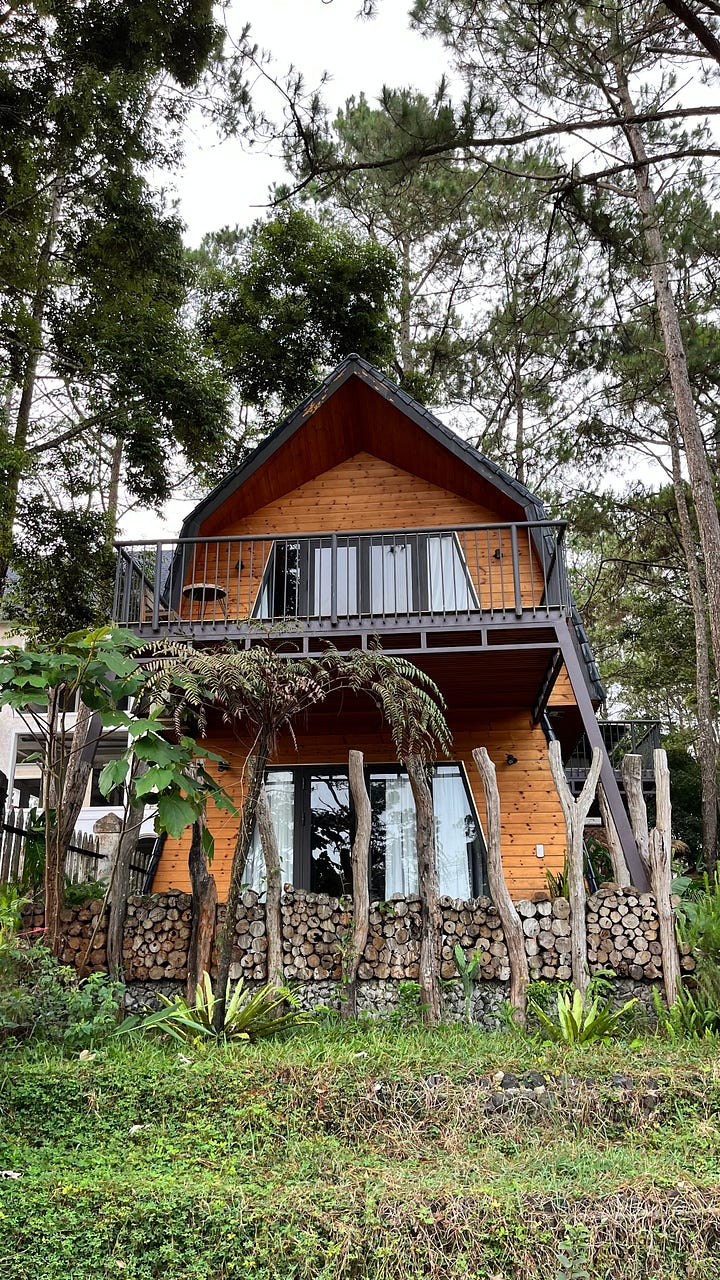
Mang Den versus Da Lat: a comparison
Instead of saying Mang Den is a dupe for Da Lat, I will briefly compare the two and then list the highlights and downsides of Mang Den.
Both towns are located in the Central Highlands of Vietnam, Mang Den at 1,200m elevation and Da Lat at 1,500m. They have a similar climate with cooler temperatures and more rain than on sea level areas. They each offer spectacular mountain views and exciting switchback rides. Although Da Lat is more known for its fresh produce, Mang Den also has an abundance of local farms, and both regions produce coffee and tea.
But that’s where the similarities end. Da Lat is a major town drawing 7 million tourists a year with a population of about 400K (some sources say 250K, others 600K, so don’t take my number as a fact). Mang Den has a population of only 7K and over 1 million visitors per year. In Da Lat, traffic is a constant nightmare and the town is always busy. Mang Den sees crowds only in the weekends, and even then the atmosphere is far from hectic. Da Lat offers pricy boutique hotels with tiny rooms. The tree-lined roads leading away from the small center in Mang Den have European-style chalets where you can rent a spacious room and live with a family for a day, or a month.
Mang Den is not an undiscovered jewel, but it’s surely less overrun than Da Lat, and I prefer its relative calm. Some claim Da Lat has lost its identity to its own popularity. Then again, you will only find the mind-blowing Crazy House and the impressive Linh Phuoc Pagoda in Da Lat. Ethnic minority groups have dwelled in Mang Den for ages, but the town doesn’t have a historic quarter with French villas and royal palaces as does Da Lat. Mang Den also lacks a spectacular cable car taking you down from the town to a huge lake below.
Still, Mang Den has its own highlights. Some of which I will list below.
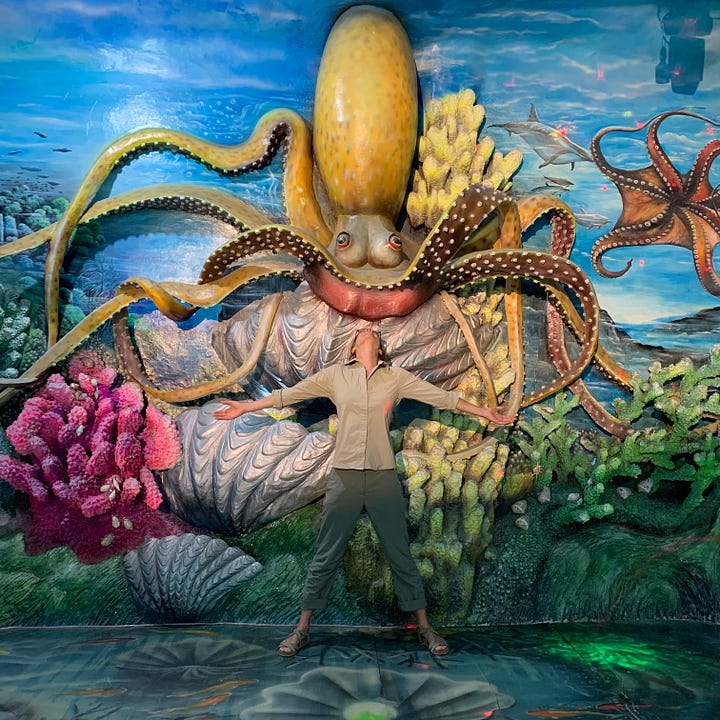

11 Mang Den Highlights
Early morning cloud hunting. There’s a road above the town where people go to be enchanted. They arrive to see the sun rise and watch the landscape when the mist still clings to the ground below. They wait peacefully until the clouds drift off or slowly evaporate. I hiked up there only once, yet took enough impressions with me to last for days. What does it mean to be in the mountains? Whenever I see the world from above, gaze down at a valley from a height, I feel small and mighty at the same time. Small in comparison to the immensity of the land and mighty for my ability to reflect upon what I see, both out there and inside my head. Mountains invite me to contemplate ideas that drift toward my consciousness like early morning clouds.
Sum Villa (Homestay). Where you lodge can make a huge difference in your appreciation of an area, and Daniel and I were so lucky our friends had suggested the charming Sum Villa. The husband and wife who manage the place are artists (making tattoos & macramé) and word of mouth draws in other artists and writers of all stripes. The hosts also prepare delicious lunches and dinners for guests who don’t fancy going into town or ordering in.
The Pa Sy waterfall is not the most spectacular fall I’ve ever seen, but it was a lovely area to visit. The water drops from 50m high and can be viewed from a bridge and from several wooden structures offering shade on both sides of the stream. Groups gathered around their picnics or were enjoying a drink at the café.
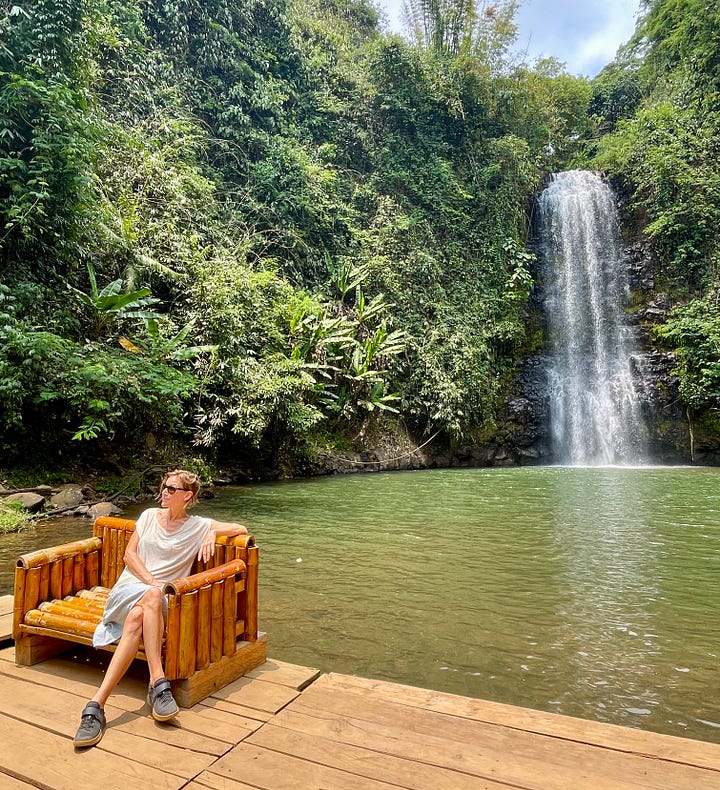

Am I doing the Instagram posing thing right? And a friend on a bridge. A scenic area with a view of rice paddies by the river. We hiked down a steep yet paved road to a picturesque metal suspension bridge. Across the bridge, stone steps led to the riverbed, where the water was clean and calm enough for swimming. There was even a café for drinks.
The Khanh Lam Pagoda. One morning, I hiked up the hill to visit the pagoda whose gong I could vaguely hear in my sleep at 4am. I climbed its 200 steps to reach the main grounds and found myself alone with two caretakers. I strolled among the gorgeous buildings and photographed a gallery of stone monks with interesting expressions.
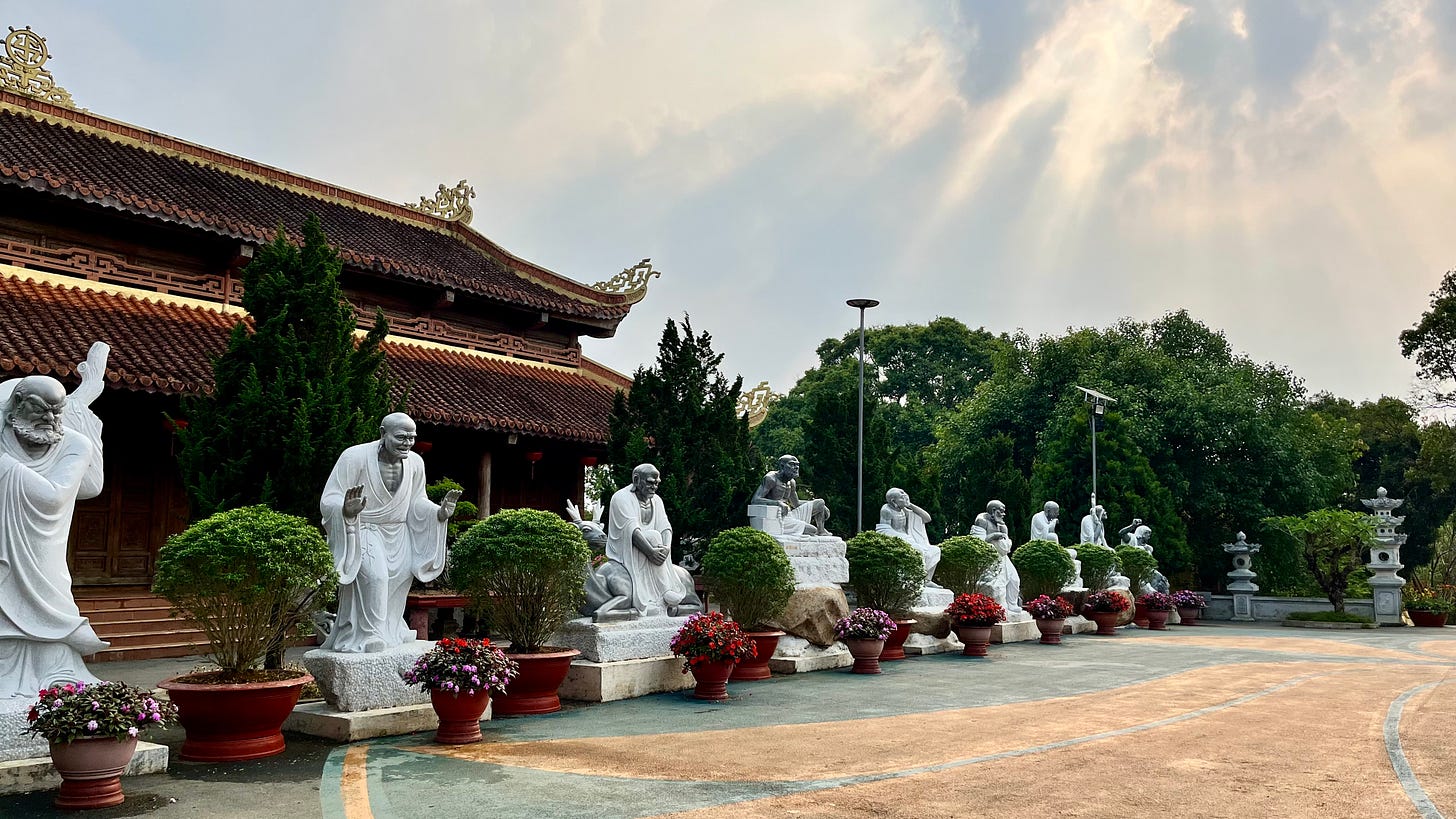
The Khanh Lam Pagoda and its gallery of expressive monks On Friday night, the Saturday market sets up. From bamboo stalls, we bought cassava cakes and tasty roasted seeds whose name eludes me. In front of traditional rice storage houses, ethnic minority groups performed traditional dances to the sound of gongs. There were also stalls with essential oils, medicinal herbs, and handicrafts. One was run by our very own Sum Villa hostess selling her macramé (find her on Instagram).
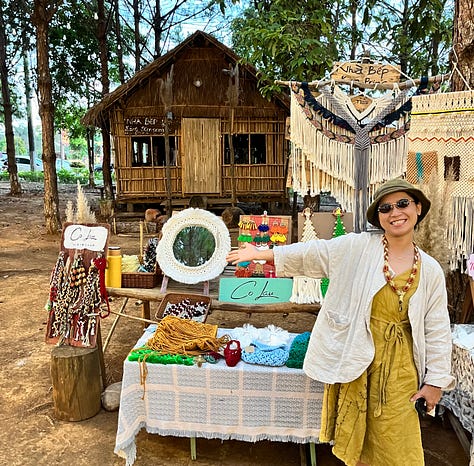

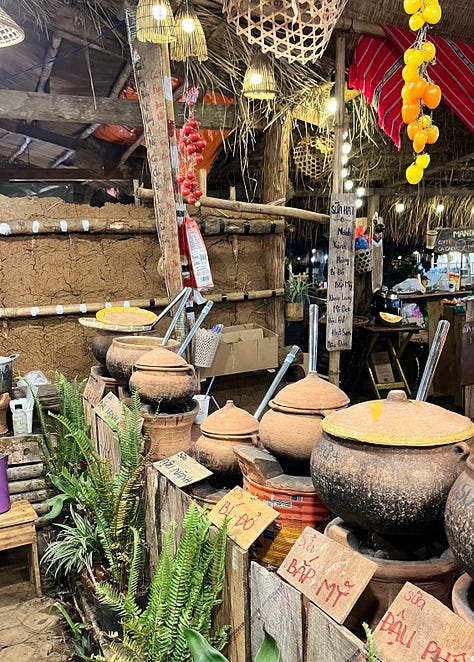
Saturday market offerings. Don't ask me about the second photo. The fresh food market is open from sunrise to sunset and offers all you need: fresh fish, seasonal fruits, all kinds of vegetables, tofu, nuts, and snacks.
I regret having missed out on the opportunity to visit a vegetable farm. But depending on the season, you can pick oranges from a grove or get lost in strawberry fields. At a café, I did see how passion fruits grow, much like tomatoes on vines.
The café culture. There are endless coffee shops in and around Mang Den. They offer rustic seating in the mountain air with scenic views or sleek, modern interiors. Some think huge statues of King Kong will entice you to come inside.
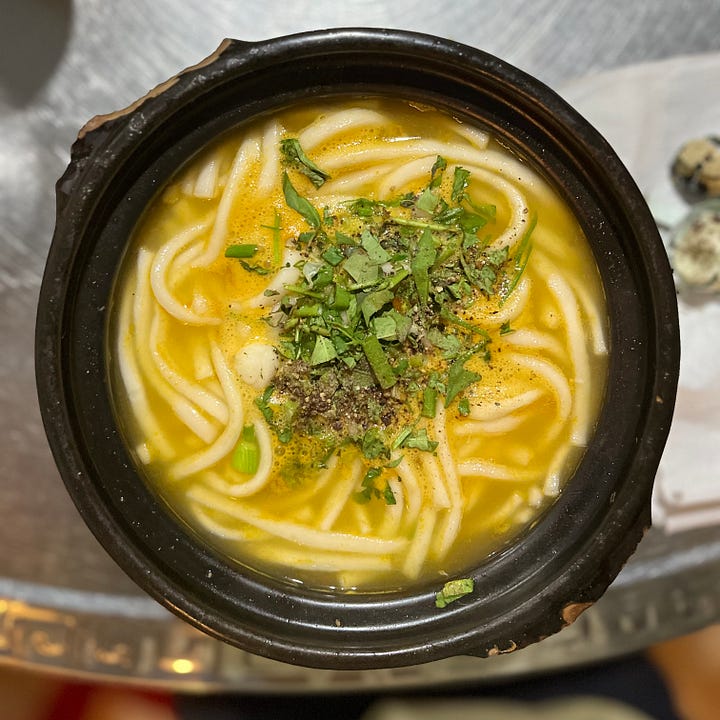
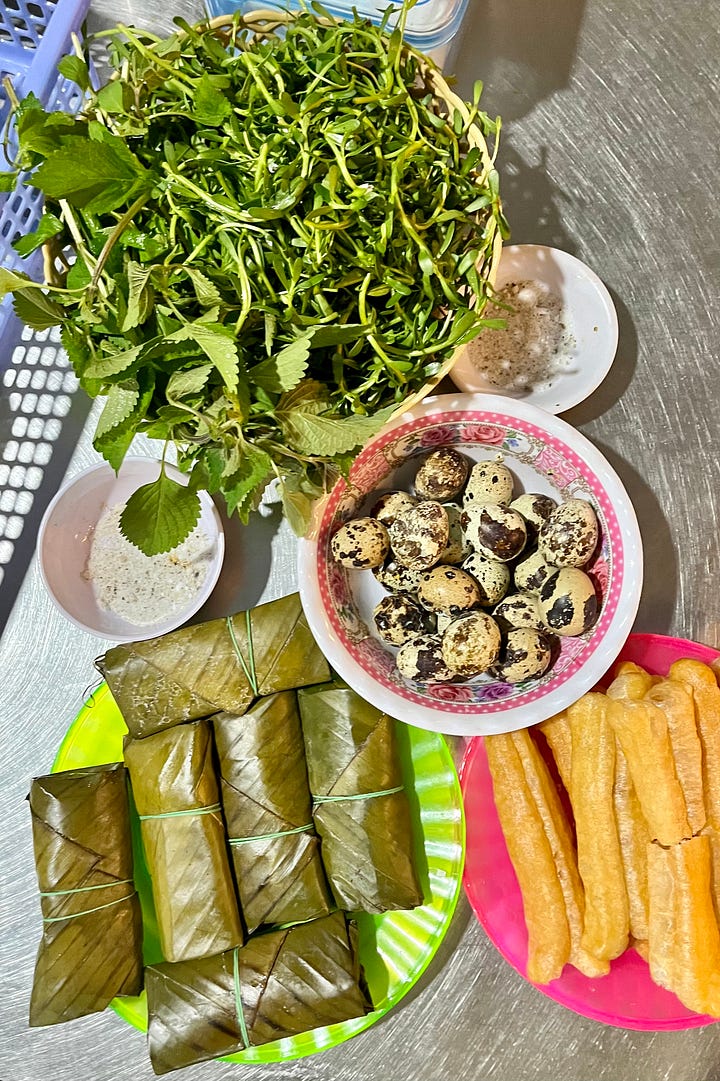
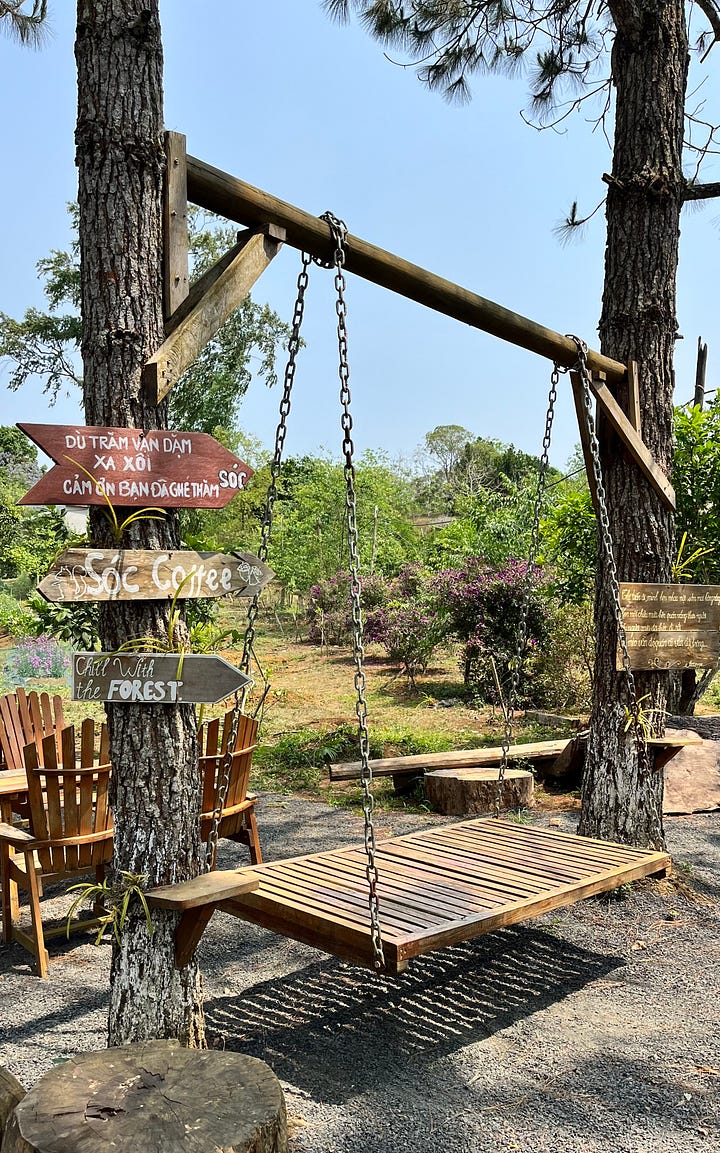
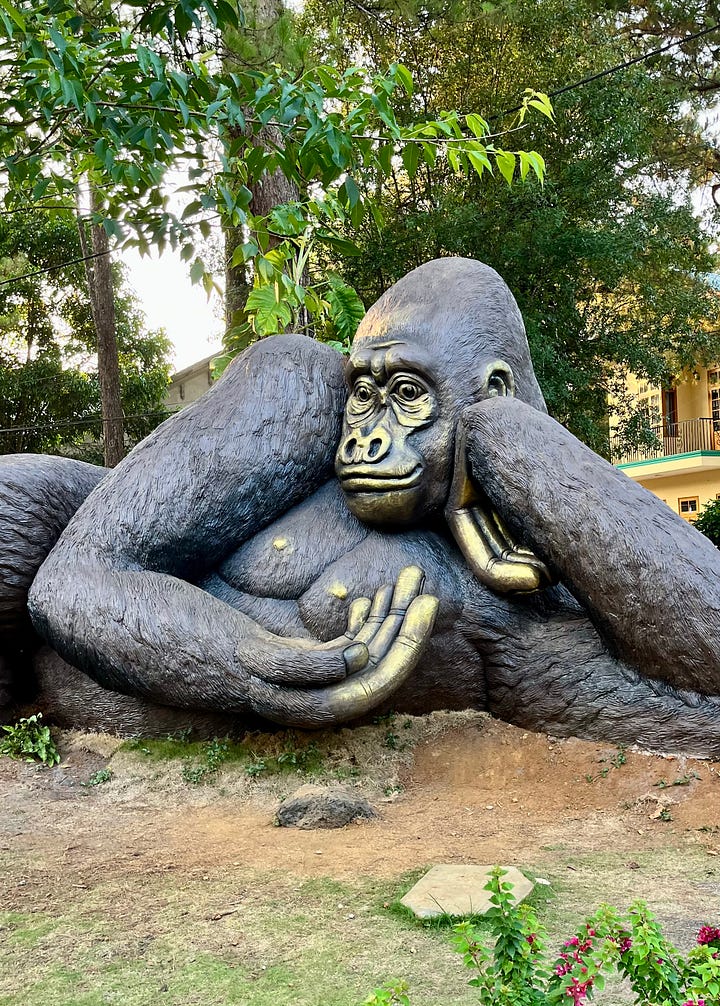
Is Mang Den a foodie town? Perhaps. I, at least, had some excellent meals there. Sturgeon cooked in a hotpot or from the BBQ. Grilled herbed chicken with savory sticky rice served in bamboo tubes. Heaps of stir-fried forest greens and banana flower salads. Sizzling snakehead fish noodle soup. Most of what you eat in Mang Den will be fresh off a local farm or picked from a garden. There are many reasons to love Vietnam, but delicious food is surely one of them.
The Mang Den Pass. The road to Mang Den from Da Nang is scenically surrounded by pine forests and offers sweeping views. The asphalt is new or well maintained, which makes driving easy, yet it unfortunately spells deforestation: This road was not built for touristic traffic alone. It’s there for lumber trucks, as we experienced during our adventurous ride to the top.
5 Mang Den Downsides
Downsides aren’t often mentioned when I read travel recommendations. Probably because they don’t fit in the formulaic Best Things to Do in Mang Den. But I always appreciate it when travelers frankly share their disappointments. Because what destination doesn’t have drawbacks?
So here I go:
There are few (or rather none that I could find) accessible hiking trails. You can walk the barely trafficked streets and traipse around Dak Ke lake, but there are no paths taking you inside nature from the town. Perhaps they exist yet haven’t yet been mapped, or they require a motorbike to reach.
Mang Den isn’t as quiet as it could be. Most homestays, restaurants, and cafés blare music all day, and because Mang Den is a weekend retreat for groups, Karaoke is popular. There’s also a lot of construction. In other words: It’s no different here than in the rest of Vietnam.
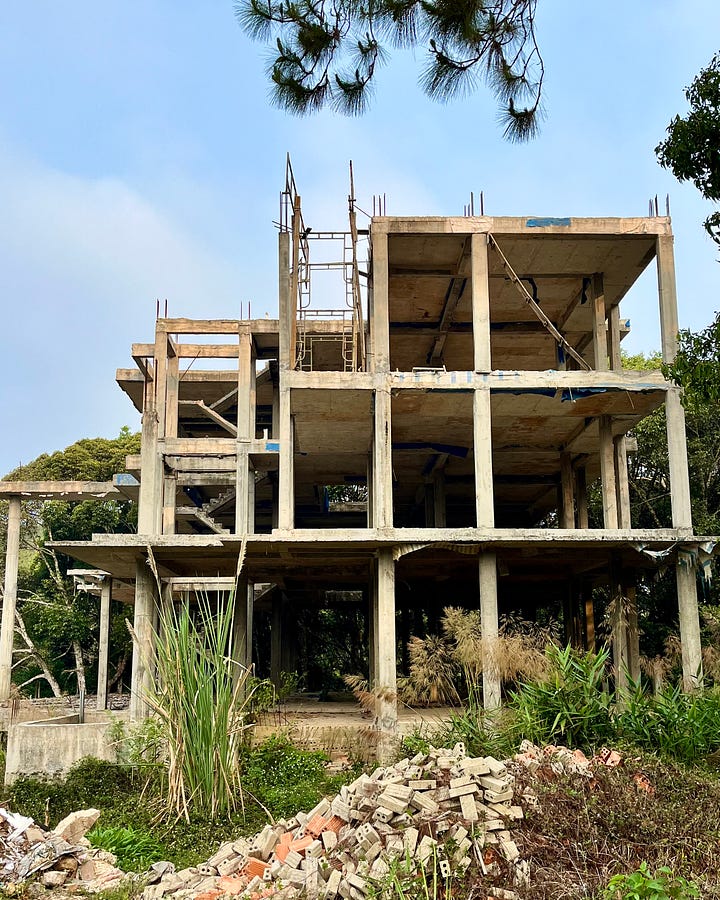
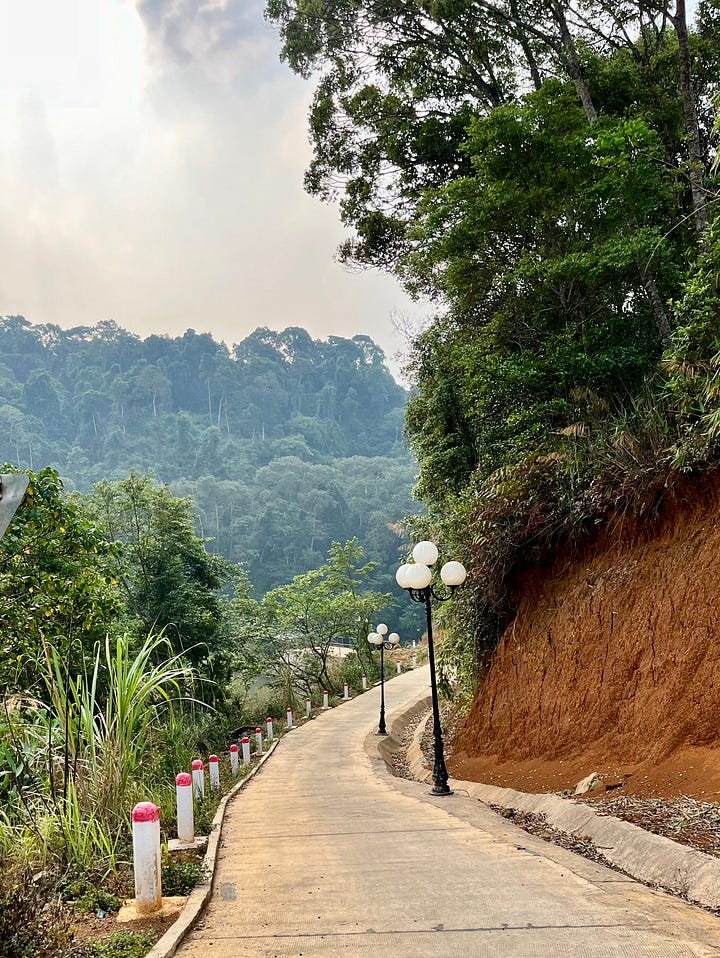
Typical sights of Mang Den The nicer homestays are located away from the town and require you to walk 30-45 minutes to get to the center. There are no Grab bikes or cars (an Asian version of Uber) in Mang Den. And no bicycle rental service as far as I know. Yet you are always close to the main road which has sidewalks and restaurants.
Since most visitors stay only for one night, a sense of community seems to be lacking. The only locals we met work in the tourist industry. But with the extreme temperatures in Vietnam and throughout Southeast Asia, which are predicted to last due to climate change, Mang Den is bound to draw more people looking to escape the heat. And not just for one day. It explains all the construction. I’ve heard credible rumors that Mang Den is getting more popular as a residential area and might soon have a co-working space and what all not. This year, the music festival REC Vietnam is already skipping Da Lat and will land in Mang Den instead.

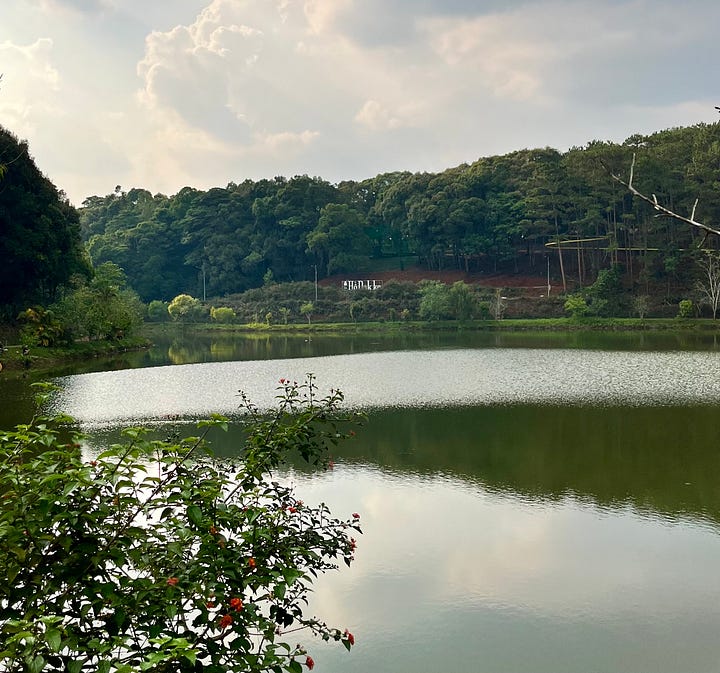
The popular Dak Ke lake looks likes its heyday was several decades ago. The wooden docks and boardwalks have fallen into disrepair and the lake is polluted. Although still beautiful in photographs, it’s not picture-perfect in reality. But let’s be honest, what reality ever is?
Time to Say Goodbye
Daniel and I came down from the mountain with the wisdom of clouds and will now pour this wisdom into our manuscripts. We’re both deep into rewrites, editing each other’s work, reinforcing character arcs, strengthening plot lines (think: cutting unnecessary diversions), and getting excited for the end result.
Is anybody waiting for a contemporary gothic mystery masquerading as a love story? A novel on the long shadows of colonialism? A book about oppressive beauty standards and the freeing magic of storytelling? Well, I got you covered. With patience, this dark novel will see the light and perhaps finds its way into your hands.
All my best,
Claire
P.S. We’re back in Hoi An and a 12th-century road was newly discovered in nearby My Son. Just in case you were wondering: My Son sanctuary is NOT a dupe for the temple complex Angkor Wat.


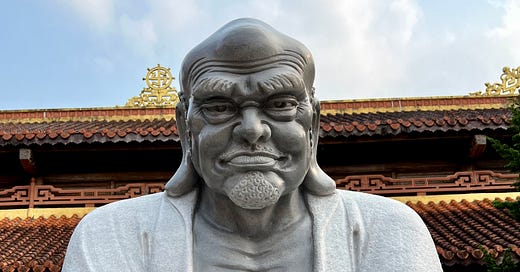


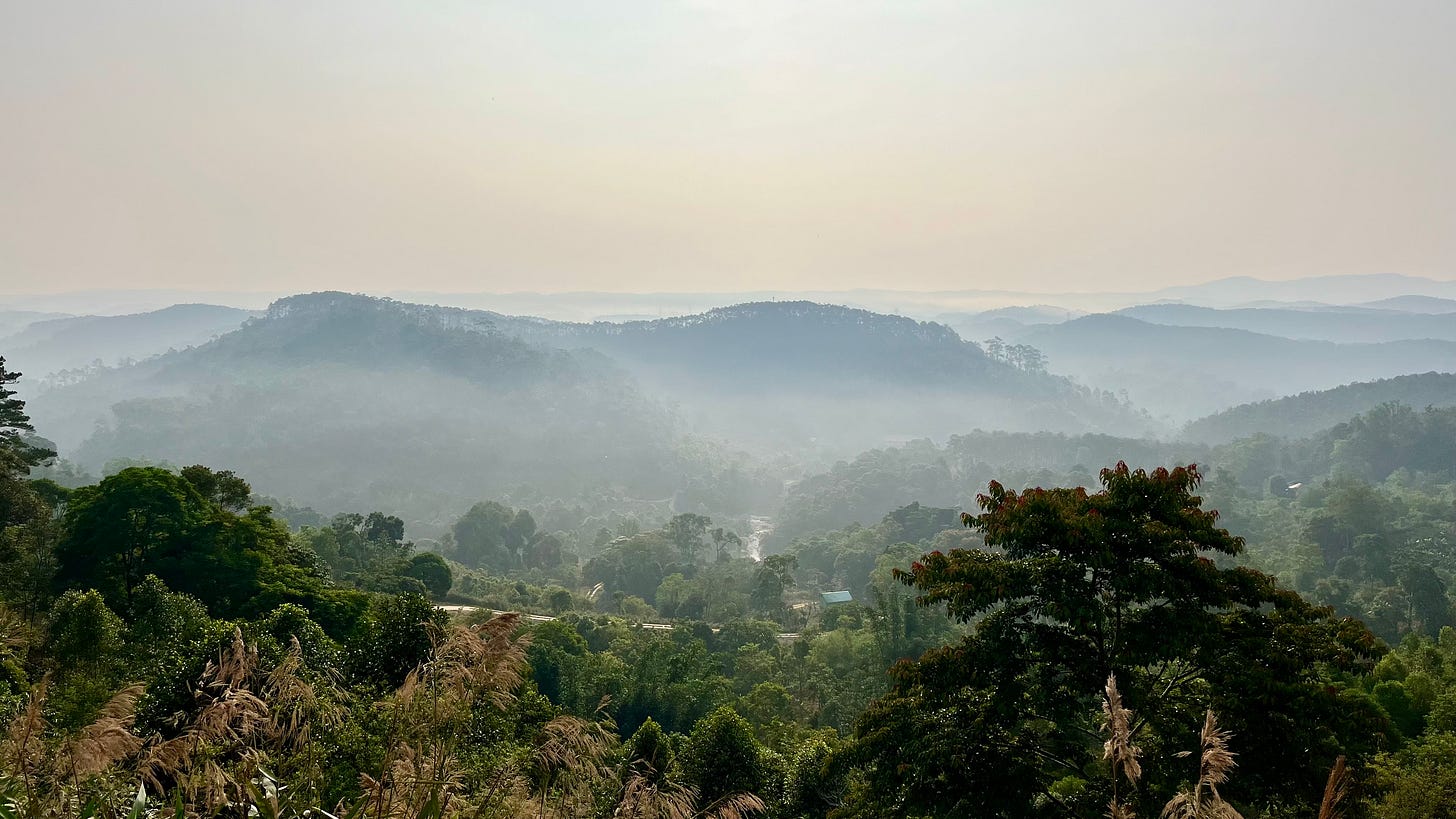
I wish I'd know about Mang Den when I was in Vietnam a few years ago! It sounds like a true gem. Most other travelers I met talked about Da Lat, so it makes sense by your description that's become overcrowded. Thanks for the interesting read!
I didn't know about Dupes destinations! thank you for sharing this information!